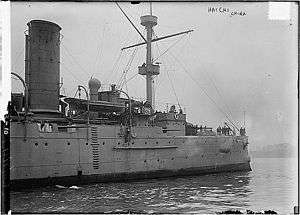Chinese cruiser Hai Chi
 Hai Chi on 11 September 1911 in New York City | |
| History | |
|---|---|
| Name: | Hai Chi |
| Launched: | c. 1897 |
| Fate: | Scuttled on 12 August 1937 |
| General characteristics | |
| Type: | Cruiser |
| Displacement: | 4,300 t (4,232 long tons) |
| Length: | 129.3 m (424 ft) |
| Beam: | 14.3 m (47 ft) |
| Draught: | 6.1 m (20 ft) |
| Speed: | 24 knots (28 mph; 44 km/h) |
| Complement: | 476 |
| Armament: | 2 × 8-inch (203 mm) guns |
Hai Chi (Chinese: 海圻; pinyin: Haiqi; literally: "Boundary of the Sea") was a cruiser of the Imperial Chinese Navy. She was the largest warship in China with a displacement of 4,300 tons, and was armed with two 8-inch (203 mm) guns and a top speed of 24 knots (44 km/h; 28 mph).[1] She subsequently served in the Republic of China Navy, before being scuttled in 1937. The hull of the vessel was raised in 1960 and subsequently broken up.
.jpg)
History

Hai Chi was built in 1897 by Armstrong Whitworth in Newcastle upon Tyne.[2]
In 1911, Hai Chi visitied the United Kingdom to participate in the fleet review held to mark George V's coronation. It also visited Newcastle for an electrical refitting at Armstrong Whitworth. Due to the occurrence of the Torreón massacre in Mexico, its mission was extended to include a visit to the United States, Cuba and Mexico. On 11 September 1911 she was the first Imperial Chinese Navy vessel in American waters.[2][3][4] While the ship was in Cuba, Mexico agreed to Chinese demands for reparations and action against the rebels, and the last leg of the ship's mission was cancelled. Hai Chi sailed home and arrived to a new government, the Republic of China having replaced the Qing empire while the ship was away.
Hai Chi served in the Republic of China Navy thereafter. In 1917 it was part of the fleet which jointed Sun Yat-sen's Constitutional Protection Movement against the Beijing government. In 1923 it returned to the north, but in 1926 joined the Fengtian faction of Zhang Zuolin, in Manchuria. After the loss of Manchuria to Japan in the Mukden Incident in 1931, Hai Chi moved to Qingdao along with the rest of the Fengtian navy, and became part of the ROC Navy's 3rd Fleet. In 1933, due to a dispute with the fleet commander over pay and expenses, Hai Chi along with two ships travelled south and joined the Guangdong navy. In 1935, due to a dispute with the governor of Guangdong province, Hai Chi together with another ship fought its way past a blockade to reach Hong Kong, and eventually to the capital Nanjing, where (as a compromise) they were nominally returned to the Third Fleet, but in reality came under the direct command of the ministry of defence.
The ship was destroyed on 12 August 1937 when she was scuttled in the Yangtze River to block the Japanese naval advance in the Second Sino-Japanese War.[1] Its main guns were dismantled before the scuttling, and installed on the river defences of Wuhan.
References
- 1 2 "Hai Chi of the Imperial Qing Navy". Blogger. Retrieved 2010-12-18.
The Hai Chi was the largest warship of the Qing Imperial Navy; it had a displacement of 4300 tons, armed with two 8 inch guns and a speed of 24 knots. ...
- 1 2 "Flag, Pearl & Peace". Time magazine. July 17, 1933. Retrieved 2010-12-18.
The cruiser Hai Chi ("Flag of the Sea") earned in 1911 the distinction of being the first Chinese war boat ever to visit the West when she steamed as near as possible to the Coronation of King George V, discharged a cargo of Chinese emissaries in gorgeous silken robes. Built in 1897 the Hai Chi and the equally venerable Hai Shen ("Pearl of the Sea") were still listed last week as the only cruisers in China's Northeastern Squadron.
- ↑ "Chinese Cruiser Welcomed To Port. First Ship Flying the Yellow Dragon Flag to Anchor in American Waters". New York Times. September 11, 1911. Retrieved 2010-12-18.
Who cruiser Hai-Chi of the Imperial Navy of China, the first vessel of any kind flying the yellow dragon flag of China that has ever been in American waters, steamed into the Hudson yesterday morning and anchored in midstream opposite the Soldiers and Sailors' Monument, at Eighty-ninth Street.
- ↑ "Men Of Chinese Cruiser Hai-Chi Are Entertained". Christian Science Monitor. September 12, 1911. Retrieved 2010-12-18.
Officers and men of the Chinese cruiser Hai-Chi, which arrived at this port Monday, are to be given ample opportunity to see New York during their stay of 10 days here. ...
External links
- Chinese cruiser Hai Chi from the Library of Congress at Flickr Commons